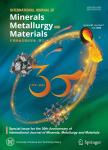Formation and thermodynamics of CaS-bearing inclusions during Ca treatment in oil casting steels
Formation and thermodynamics of CaS-bearing inclusions during Ca treatment in oil casting steels作者机构:Collaborative Innovation Center of Steel Technology University of Science and Technology Beijing
出 版 物:《International Journal of Minerals,Metallurgy and Materials》 (矿物冶金与材料学报(英文版))
年 卷 期:2019年第26卷第5期
页 面:573-587页
核心收录:
学科分类:0709[理学-地质学] 0819[工学-矿业工程] 08[工学] 0806[工学-冶金工程] 0708[理学-地球物理学] 0805[工学-材料科学与工程(可授工学、理学学位)] 0703[理学-化学] 0802[工学-机械工程] 0801[工学-力学(可授工学、理学学位)] 0702[理学-物理学]
基 金:financially supported by the National Natural Science Foundation of China (No. 51574026)
主 题:CaS inclusions Ca treatment electrolytic extraction thermodynamics three-dimensional investigations
摘 要:Industrial experiments were carried out to investigate the formation of CaS-bearing inclusion during Ca double modification in oil casting steels using polished cross sections and electrolytic extraction. Immediately after Ca addition, the role of newly generated CaS as an intermediate reaction product, which modified the Al_2O_3 inclusion into a liquid calcium aluminate, was confirmed. The formation of transient CaS was attributed to the high surface segregation of S at the liquid steel-calcium vapor interface, where a simple site coverage model based upon the Langmuir adsorption equation was established. Moreover, a CaS outer layer surrounding the liquid calcium aluminate was attained mainly in the tundish, which was distributed unevenly on the surface of liquid particles according to the three-dimensional mapping results. The surface of a well-modified calcium aluminate with higher CaO activity and Al_2O_3 activity under bulk composition conditions in the tundish acted as a favorable site for the generation of CaS. Additionally, CaS could be precipitated directly onto existing inclusions during solidification of the steel, which led to various morphologies of CaS-bearing inclusions in slabs. Furthermore, the phase transformation of inclusions during solidification was strongly influenced both by the S content and the Ca/S ratio in the tundish via thermodynamics.



